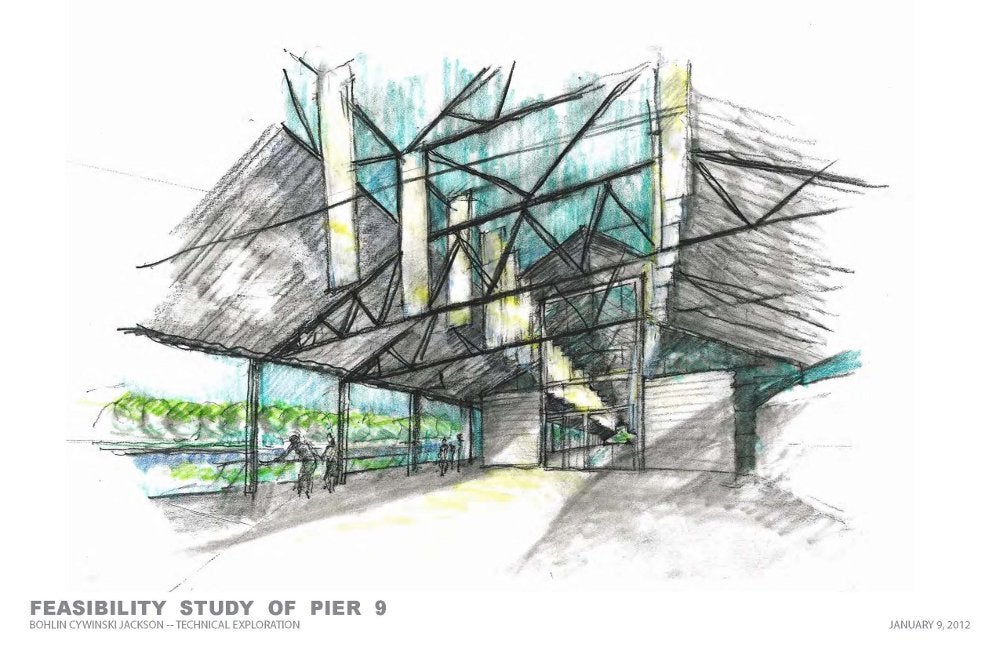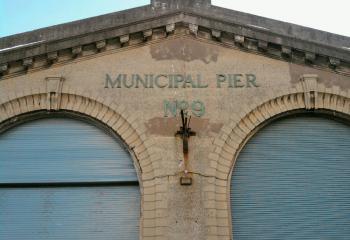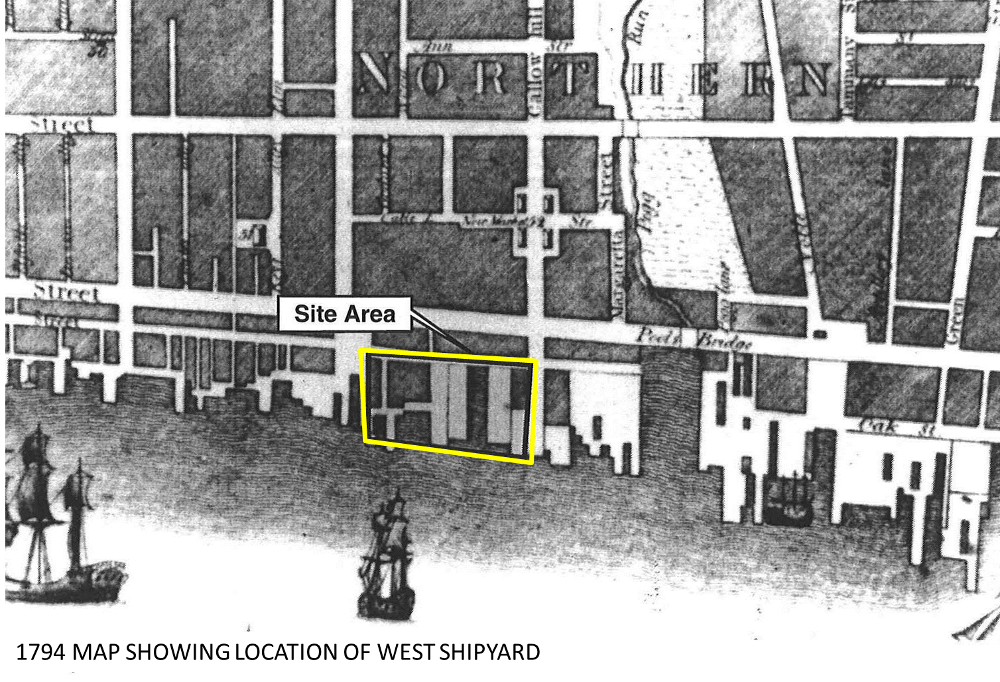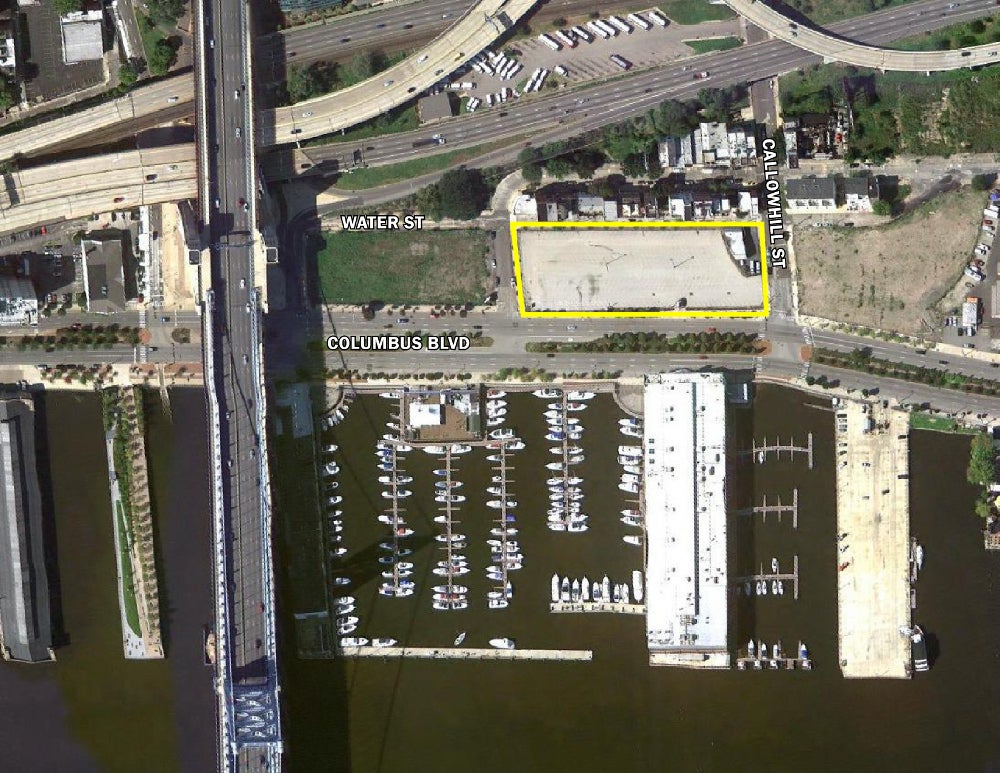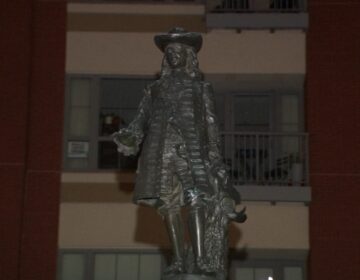DRWC talks about Pier 9’s future and a parking lot’s past
Pier 9 – the municipal space with a large building on it that sits next to Race Street Pier – could one day boast on open-air porch, cafe-seating overlooking the neighboring pier and the Ben Franklin Bridge, and flexible indoor space that could be divided for small events or left open for huge ones.
Those are some of the early ideas from a Bohlin Cywinski Jackson feasibility study on the future of the pier that the Delaware River Waterfront Corporation Board of Directors learned about at Friday’s meeting.
But while something that transformative of the old, blue-sided pier is possible, the board must first determine if, and when, it would be worth the cost – a cost that is still being determined. The feasibility study is being done in two parts. The first will look at what it would take to ready the space for event rentals. The second, longer-range portion will examines possibilities for permanent tenants that could come after that, with more time and money.
“The steel is in good condition. That’s the good news,” DRWC Vice President Joe Forkin told the board. “The rest of the building is not so good, and that’s the bad news.”
The pilings and the structure look sound, but the cladding will have to be replaced, as will the clerestory windows, which do not function. Right now, the pier has only one entrance, so at least one more will be needed for fire-safety reasons.
“We’ve asked them to come up with a space that’s really flexible, so sometimes we could use a part of it, and sometimes the whole thing,” said Planning Director Sarah Thorp. The whole thing amounts to about 40,000 square feet of usable space, she said.
The board’s real estate committee will use the feasibility study to weigh the return DRWC could get for each level of investment. “Do we want to continue to own it? Lease it? These are all things for the real estate committee,” said Board Member Marilyn Jordan Taylor.
Board Member Bill Hankowsky said one option might be bringing the building up to standards allowing for event rentals and using it that way for a certain period of time, then examine the market to see what it bears down the road.
The board is updated on the Pier 9 study and other on-going projects.
In its current state, the pier was the site of last year’s Feastival – Philly Fringe’s huge annual fundraiser.
The board heard reports on many other ongoing projects, including the Columbia Avenue Connector that would link Fishtown to the riverfront at Penn Treaty Park. the northern half of the Race Street Connector project and the riverfront trail.
It also got updates on three future projects: The Spring Garden Connector; Phase II of Washington Avenue Green; and preliminary archaeology work to determine what lies under the parking lot covering a bit of Philadelphia’s original shoreline.
The Spring Garden Connector project will link Northern Liberties to the waterfront at Festival Pier. Planners are excited because Spring Garden offers so much room to work with – DRWC President Tom Corcoran calls it “the mother of all connector streets.” They are also pleased to have so many other partners who are investing in corridor improvements, including the Pennsylvania Environmental Council and the Northern Liberties Neighbors Association. Corcoran said he wants another partner: SEPTA. The El stop at the I-95 underpass offers huge possibilities not only for bringing people to the waterfront, but for transit-oriented development. The problem, he said, is that it’s current state is so dark and frightening, it could be the movie set for drug deals and other unsavory activity.
At Washington Avenue Green, DRWC plans to expand the current upland park with more wetland restoration and some sort of boardwalk that allows public access to the water, Thorp said. Forkin said DRWC has been talking to the Philadelphia International Airport and other potential partners who may need to restore wetland habitat to make up for wetlands they will destroy as part of expansion projects.
Reports on Spring Garden Connector, West Shipyard archaeology, and Washington Avenue Green.
And then there’s the West Shipyard. Planners are drafting the RFP documents seeking archaeologists to do some test digging in a piece of rare, original shoreline beneath what is now a parking lot. “I-95 obliterated the original shoreline of the city, but I-95 bends. So in this small location of a couple of blocks, there is the original shoreline of Philadelphia underneath our parking lot,” Thorp said.
This spot between Vine and Callowhill, used as Dave and Busters parking on weekends, sits on the site of shipyards and related businesses dating from the 1600s, Thorp said. “Originally, our site was water and piers, but the shoreline was moved out by fill,” Thorp said.
The site has always been pegged for future development, but that can’t happen without first exploring it, she said. In the 1980s and 1990s, archeology on the north side of the lot found the remains of an old slipway that is one of the oldest on the east coast. The southern portion has never been explored, Thorp said.
DRWC won a $25,000 grant from the Pennsylvania Historical and Museum Commission to do this preliminary work, which will determine if more should be done. DRWC is adding additional money from a previous William Penn Foundation grant and staff time and services that will bring the project total to $75,000, Thorp said. Work is set to start this summer.
WHYY is your source for fact-based, in-depth journalism and information. As a nonprofit organization, we rely on financial support from readers like you. Please give today.



